

*****************************************************************************************************************************************************************
MAY 2016 UPDATE
*****************************************************************************************************************************************************************
PETE JOHNSON *****************************************************************************************************************************************************************
KIER HARDY Unfortunately due to the flooding that occured at the Baildon Green Recreation Centre,
the 2016 exhibition has had to be cancelled. Here's a quote from the SMRS website - :
Shipley Model Railway Society was badly affected by the floods on Boxing Day
last year. The ground floor of the premises was flooded to a depth of approximately seven feet. The clubrooms, on the top
floor, were not flooded but access for normal club activities is still not possible as, amongst other damage, the
emergency lighting and fire alarm systems were damaged beyond repair. Following the flood there was concern that the
building might not be recommissioned. The club has now received assurances that the building will be reopened but, as yet,
there is no time table for completing the work. Because of this the society has reluctantly decided to cancel their 2016
exhibition which was planned for September. Meanwhile the club continues to be very active and our layouts are fulfilling
bookings at other exhibitions around the country. Updated 11/4/2016
We wish them all the best and a speedy return to normal.
*****************************************************************************************************************************************************************
KIER HARDY *****************************************************************************************************************************************************************
PAUL JAMES I was left with a bit of a dilemma as the loco would have to be a vacuum only one, (that was what the main
cooler group configuration was) and the spare roof section with the boiler exhaust was of the Clayton boiler
type. A quick check through my books soon found that vacuum only Clayton boilered locos, (D1639 to D1681),
had already been dual braked in the time period I was modelling. As a Spanner boilered option was ruled out,
the model having been one originally, that left either a Stones boilered loco or one with no boiler at all.
The latter was a non-starter as all had been dual braked from new. Of the Stones boilered variety a bit of
research found 13 Stones boilered locos that had been vacuum only, D1618 to D1630. Three, D1620/1/4 had been
dual braked too early for my purposes, but the rest were OK. (D1622/3 even managed to receive TOPS numbers,
47041/2, before being dual braked).
*****************************************************************************************************************************************************************
KARL CROWTHER *****************************************************************************************************************************************************************
JUNE 2016 UPDATE
*****************************************************************************************************************************************************************
KIER HARDY *****************************************************************************************************************************************************************
PETE JOHNSON *****************************************************************************************************************************************************************
JULY 2016 UPDATE
*****************************************************************************************************************************************************************
KIER HARDY *****************************************************************************************************************************************************************
PAUL JAMES at *****************************************************************************************************************************************************************
AUGUST 2016 UPDATE
*****************************************************************************************************************************************************************
HYWEL THOMAS *****************************************************************************************************************************************************************
KEITH TRUEMAN *****************************************************************************************************************************************************************
PETE JOHNSON *****************************************************************************************************************************************************************
KIER HARDY *****************************************************************************************************************************************************************



Lately more projects seem to have been started than finished, and the past month has continued
the trend…….First up is a Hornby SR Q1 re-gauged to EM using Gibson parts, and slightly complicated by Hornby
using 3.0 mm metric axles rather than the more traditional 1/8”. The brake gear mouldings of this otherwise superb
model are also not very helpfully constructed for those devoted to the wider gauges of 4mm modelling.

The slow progress on the pair of North British 0-4-0 kits continues, but a first coat of the main
livery colours has finally been applied……I’m beginning to worry that if I don’t get a move on building the models
will have taken longer than the prototypes spent in British Railways service!

Taking more of a fast track has been this Bachmann Class 20, to be finished as D8041 in as-delivered
green and grey of 1959. An etched fan grill, wipers and laser-glaze from Extreme Etchings have usefully enhanced the model.



Instead it's been very pleasant spending more time at the lineside watching the trains go by. I captured
this English Electric type 4 number 332 on the front of a freightliner service heading south, the rake totalling 17
vehicles made up of TOPS code FFA (inner, no buffers) & FGA (outer, buffers one end).

The first block of five wagons have been transferred to the Hornsey / Wibdenshaw fleet, and are heavily
modified and detailed Hornby models with replacement whitemetal bogies.

Rebuilt by Greg Brookes originally for Shenston Road, they feature complete replacement underframe
trussing made from brass section.

The additional weight improves running and allows additional loaded wagons to be tagged on behind
them without fear of derailments on 3ft radius curves.

The next 10 wagons in the rake (CS01 to CS10) have been detailed by Pete Johnson utilising
the same Hornby model, but retaining the original plastic bogies and solid underframing. These are hired in from
the Canada Street pool (as there's not enough siding space to run them there), and feature highly detailed containers
and open crates.

CS02 is fitted with a modified 30ft container spliced together from several Hornby boxes.

CS04 is fitted with two 20ft containers, depicting the earlier Freightliner box and the
later Freightliners Limited box, both suited for the early 1970s.

CS06 & CS05. All the containers have been detailed and labelled utilising Modelmaster &
Fox Transfer sheets at a time before the Railtec transfers were available.

CS07 with Freightliner containers

CS10 & CS09 are fitted with OCL containers of 20ft & 30ft lengths.

The last two wagons in the rake are both FGA (ex-Shenston Road) as a paired twin and carry a
20ft Manchester Liners and a 10ft Freightliner container. I have yet to finish the box with a number at least.

Another two ML boxes are sitting at the end, placed conveniently to avoid doing any door detail on them.

As the freightliner train rolls away, Brush type 2 number 5552 heads across the flyover on its way north
with a postal train made up of mainly full brakes for stowage, two POS sorting vans and a BSK for carrying personnel.

This fairly straightforward modification has been carried out on the Hornsey fleet, as per the
feature mentioned last month on the Shenston Road update. On the left is a BG, a BSK in the middle, and a
completed BG on the right.

BSK number E35445 having had the water filler converted to a handrail, and some fresh blue paint over
the areas of recent modification.

In practice the two sorting vans would probably be the same way around for ease of
loading through the wider doors at platforms, but are placed this way around for asthetic reasons.

The maroon BG is a recent acquisition and adds some colour to the consist.

An all-over blue BG hitches a lift on the back end.
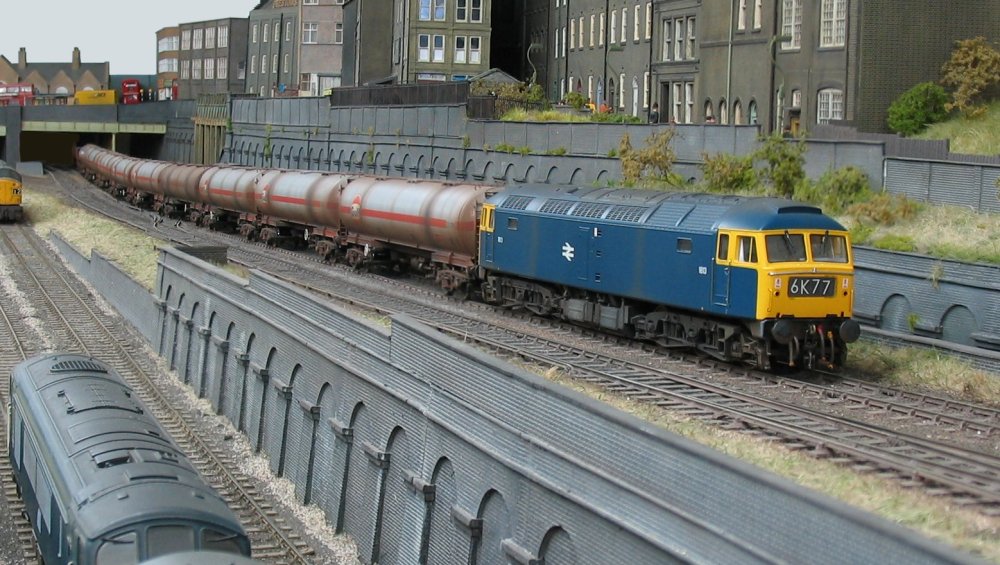
From the Shenston Road direction comes Brush type 4 number 1813 with a rake of Gulf tankers presumably
heading for Thames Haven.
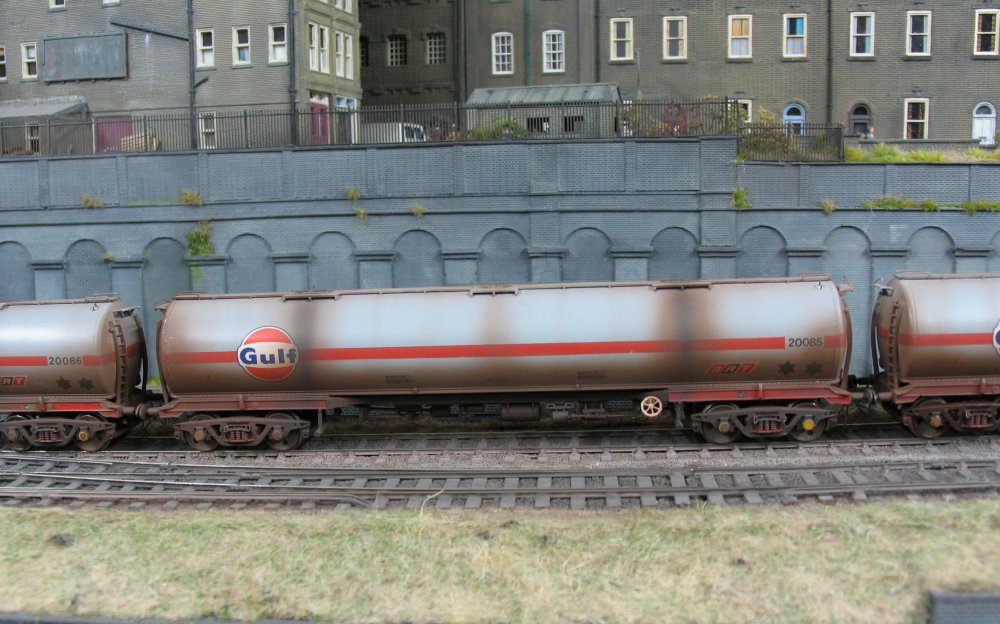
The April update showed Greg's recent tank wagon project, the detailed and re-liveried Bachmann models.
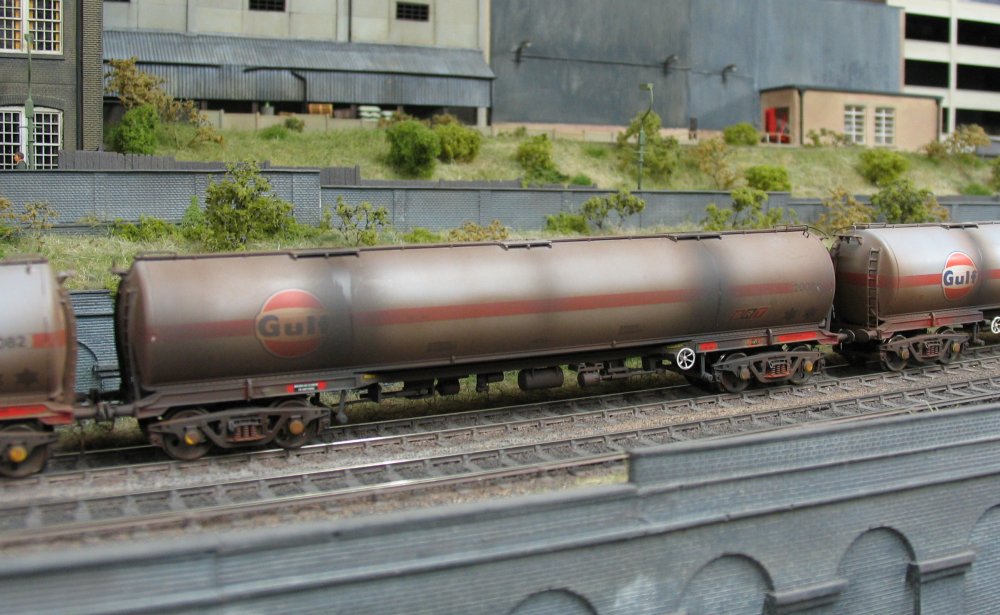
Now finished and in to service......
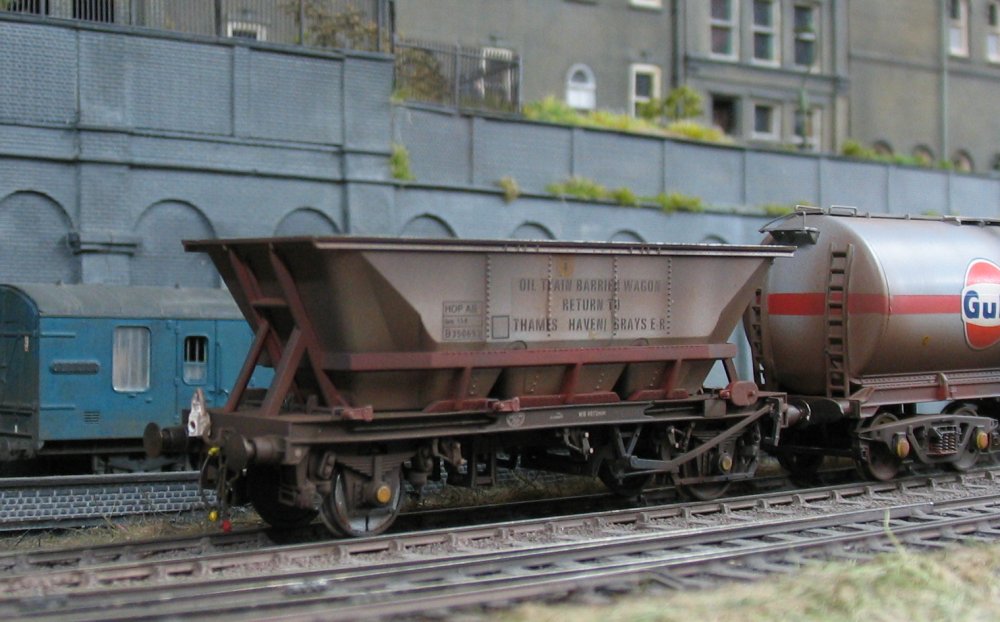
...... with a HOP AB as a barrier vehicle.

Depicting a 1960s theme, perhaps passing a jam factory in deepest East Anglia! But alas no, just
Paul James taking his railbus along the high level branch line for a spin.

On occasions a variety of visitors can be observed, sometimes on running-in turns before heading
back home. This view shows English Electric type 3 locos on double headed coal trains passing each other.

D6992 - the latest from Bachmann, detailed and finished by Greg for his Shenston Road fleet and
depicts a 86A Cardiff Canton allocated example.

Also from the same neck of the woods (also Bachmann) 6970 in green livery.

D6963 (& 6782 shown below) - both Lima based models, converted and finished by Paul for his
Eastwell fleet, both with double motored original pancake motors in one, and skew wound Hornby Railroad motors in the other.

My Ian Allen locoshed pocket book tells me this is an unusual pairing, as D6963 is allocated to 30A
Stratford, whilst 6782 is a 41A Tinsley loco.

BTH type 1 at a distance.

A flash-back to the Shipley show in September 2015 with Hornsey on away test.

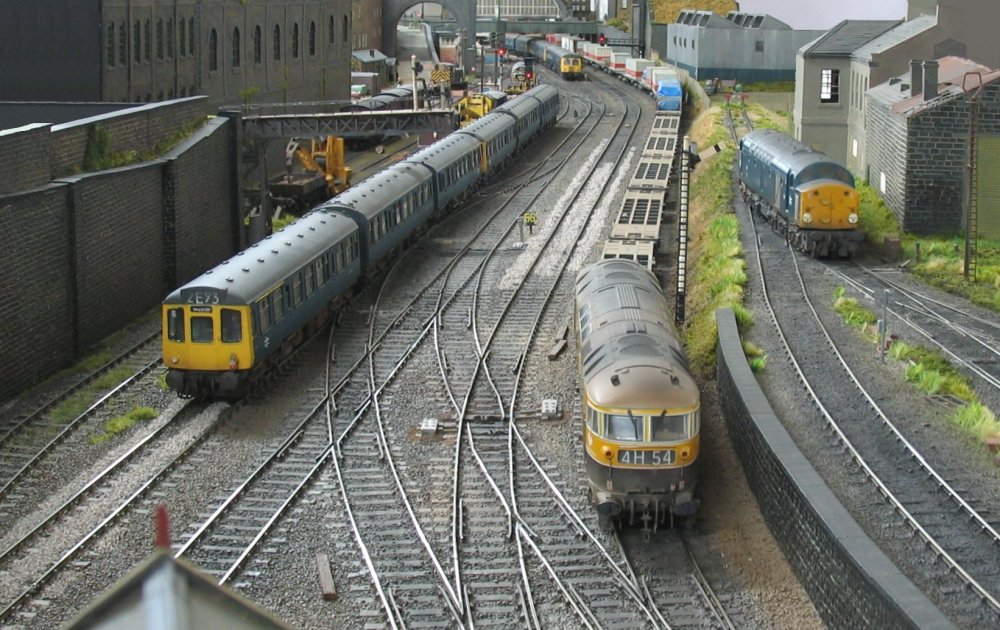



Initial trail fitting. The first thing I had to do with the boiler exhaust section of the
roof was to make it a better fit in the loco body. Some attention to straighten the sides of the hole in the
body with a file was followed with addition of plasticard strip to the edges of the boiler exhaust section
of the roof and filing and sanding back until it was a snug fit. This took a bit of patience with filing
and adding plasticard strip until I was happy.

Just about a nice fit. Note a start has been made on the new boiler exhaust port.

Finished roof section with altered boiler port in position. With the roof section a nice
snug fit a start was made on altering the boiler exhaust port to the Stones type. This involved plating over
the Clayton exhaust as modelled and making a new Stones one at the opposite end of the roof section. The
cover plate came courtesy of the Extreme Etchings range, their EEDP47-15, Class 47 Boiler blanking plates,
fitting the bill. (Note, since doing this conversion, the blanking plates etch now also includes a Stones
boiler port). As the boiler plate etch I used was an early version and didn’t include a Stones boiler port
etch, I had to make my own. This I did using an old A1 models etch on which the grill etch was a bit poor,
so I removed the grill part of the etch and added my own grill soldered behind the port surround. After
making a square hole on the roof section in the correct position, the new blanking plate and boiler port
were glued in place.

Finished section awaiting a coat of green paint to match the rest of the body.

Side view of soon to be numbered 1628. The photo selection for the time period modelled,
dictated that 1628 would be modelled in two tone green with TOPS style numbers and this is how the model has
been turned out after touching up the paintwork as required and adding numbers and other detailing.

No2 (boiler) end view of a finished 1628. A visit to the Shenston Road weathering workshops
completed the loco. Painting the cab interior and adding bulkhead detail along with the load bearing pillars
that appear in the cabside windows and a cooker on the secondmans side, both out of plastic strip. Other detail
includes some home made headcodes based on those found in photos of the loco, and adding detail to the side windows
made from resized photos of the side windows of actual locos. (Brian Daniels Flickr site are good for those).

No1 end view of a finished 1628. An interesting project that has made use of the spare bits
from another project and produced a rarely modelled example of the Class 47. Additions and alterations included cutting out
the original Heljan plastic fan grill and adding new etched fan grills from the Shawplan range along with fans.

In service, and earning its keep on 'the postal'.



It is hoped that work on the coal drops will be fully completed in time for the layout’s
appearance at Expo EM in Bracknell on May 14th/15th.

Another recently completed item of rolling stock. This LNER pattern 12-ton insulated fish
van in Express Parcels guise is based on the Parkside kit, with Mike Clark Masokits underframe parts,
including sprung axleguards.




Class 46 Peak D163 Leicestershire & Derbyshire Yeomanry at Wibdenshaw. Detailed and finished
by Greg Brookes for the Shenston Road fleet.... the loco crew obviously haven't bothered to change the headcode!

Another Peak from the Shenston Road fleet, this time D165 awaiting a clear road.

And whilst on the subject of Peaks, this example in blue livery D123 completes a trio from Greg.

D1039 Western King was captured on Pudsey Jcn stabling point.... a Dapol product again from the
Shenston Road fleet.

Where are all the trains? An unusually quiet moment at Wibdenshaw station captured by Mr James.



A couple more BR Brake Vans have been put together from the old (bright red!) Airfix kit. The
first has been adapted into the BR Diagram 1/500 pattern, carrying-over the final LNER design. For this the foot
boards have been shortened and double lamp brackets added at each end. The usual improvements to the roof and
windows have also been done.

The second Brake Van is a Dia 1/507 of the final BR pattern. For this oleo buffers and
roller-bearing axleboxes have been added.

A few Parkside van kits have also been put together. This is one of a pair of late pattern BR
Dia 1/208 vans with plank sides and ply doors. The clasp brake underframe is from the Red Panda kit, leaving
the Parkside underframe parts available for some future project…..

For a bit of variety this van is the Dia 1/233 ventilated fruit type. Externally they were
almost identical to the plywood built standard van, but the 4 air-scoop vents low down along each side
(helpfully provided by Parkside in their kit) give away its special traffic.

Finally this month, a rebuild of a scratchbuilt model I first put together back in the late
1970s for my OO-gauge layout of the time! This Dia 1/005 hot pig-iron wagon was inspired by a brief article in
a Railway Magazine from the early 1950s – when the first of the type joined the BR fleet. Based on that single
photograph, and the accompanying outline dimensions, I put together a bodyshell on an Airfix Meat Van underframe.
Found recently in a box of old stuff in the attic, the basic size of the
bodyshell was good and seemed worth doing something with….

Further research on the web, and in books gathered over the years, showed that the 139
‘production’ wagons had beefed-up framing compared to the prototype in the RM picture. As a result only the
basic body-tub of the model remains, fitted with new framing and underframe. The all-steel type were unusual
for having a sloping floor with drainage slots at the centre, this allowed water sprayed on the hot load to
run away. The heat and water did no favours to the paintwork, and rust seems to have been the general colour
of the bodywork most of the time! A sole example survives at the Nene Valley railway…..but is badly in need of some TLC.

Now a few images taken at Wibdenshaw during the recent Railex 2016 show.

An unidentified Peak speeds northbound through the station.

A long way from home, Stratford's 2164 on station pilot duties.

Deltic number 9009 Alycidon heads south with a Pullman service.

A BMC dropside captured on Bradford Road.

A series 1 Landrover crossing the railway along Sunbridge Road.

Pudsey Junction signal box.

A potential customer!

Bogie bolsters aplenty behind a BR Sulzer type 2.

A brace of Brush type 2s going with the grain.

They're all hiding in the shunters cabin.

Stop here when red light shows.

WYPTE rules OK.

A class 128 DPU pauses in the parcels bay, surrounded by BRUTE trolleys.



This DC Kits Cravens DMBS has been in the Holmeworth / Wibdenshaw / Hornsey fleet for many
years, and was constructed by the late Steve Chambers. It has recently been in the workshops for an intermediate
overhaul, along with its paired DMC which has been declassified for use on the Great Northern suburban services.
Simple enhancements such as fitting footsteps to the bogies improves the model no end (Lima detail parts as supplied
with the class 101 Met-Cam).

The trackwork just south of the station has recently been commissioned and tested, and this
involved the construction of a relay module for the control of current to the point motors. Using Veroboard (or
similar products) to mount the relay bases, it has been found in the past that the copper strip can fail under
certain conditions with hairline cracks causing an open circuit, hence the use of fully soldered tracks or
jumpers as required, leaving nothing to chance.

Showing the power relay board mounted under the baseboard. These relays are single pole and rated
at 16 amps, and are used to switch the 24v from the CDU to the solenoids. This system has proved to be rugged and
reliable with the relays lasting well over 25 years in regular service, with hopefully many more years to come. The
bank of 6 relays (4-pole) are used to switch the controller / polarity feeds to the trackwork once each route is set.

Shown here is the trackwork associated with the relay modules, giving 8 regular permutations for
routing of trains between the fast lines (nearest) and the local lines, via diamond crossovers, and a double slip
intermingled with a scissors crossover. Some evidence of fettling can be seen here, then once everything has been
tested it can be cosmetically treated.
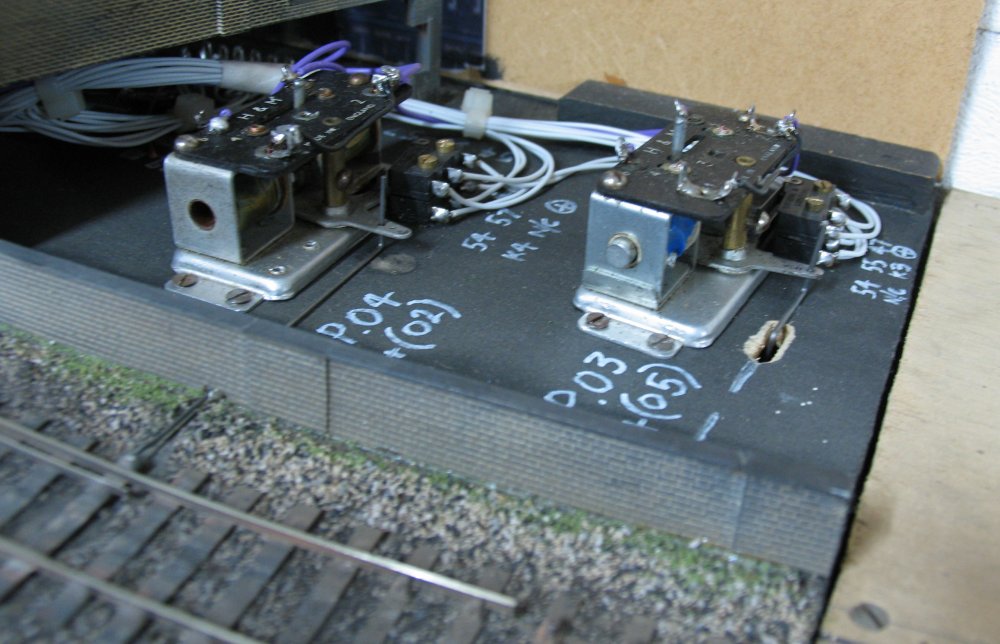
This 50+ year old technology is still being fitted and commissioned on most of the projects found
within the layouts featured on this website, this example showing H&M solenoid units with auxillary micro-switches
fitted. Other units by Kean-Maygib, Tenshodo and KTM are also used to good effect.



The express service from Paddington rolls out of the station behind D1022 Western Sentinel on the
last leg of its journey to Wolverhampton.

D1039 Western King is spotted light engine during a quiet moment in the day.

Class 45 Peak number 27 heads north through the station with a rake of empty mineral wagons.



Rivet detail aplenty!



A recent addition is this Bachmann class 37. We wish Keith and his team all the best for
the layout's first outing.





Class 71 number E5004 at rest in the station holding siding.

Another recent addition also to Shenston Road is this Bachmann class 40 number 236, seen
here on a running in turn on the postal vans.

This row of pre-fabricated shops have been empty for some time now, and with them being
right at the front of the layout it seemed logical to fit some detail.

When all the units are occupied, the building can be bedded down into the scene, and final
detail can be added such as drain pipes and street furniture.

The shop fronts are made from a piece of 2mm acrylic sheet, the sort of thing that is
often found on a gift boxed bottle of beer with a waxed cheese. It's rigid and simple enough to deep score
and snap. Spills of paint and solvent can be wiped off easily without affecting the surface, and it takes
bonded microstrip (using superglue in this case) to give the desired window and door configurations.

Just for added interest, LEDs have been fitted.... I'll meet you for a coffee
in the Cosy Cafe under the funky lampshades!